
JULIA LEE BARCLAY-MORTON – YOGA, WATER AND REWRITING AUTISM
I interviewed writer Julia Lee Barclay-Morton about her experience of autism. Julia began as an experimental dramatist in New York, moving to the UK to


Christine Rollitt is a gifted and versatile stitched textile artist, who has worked with several textile artist groups as well as design and retail companies. She has exhibited in Bahrain. London, Newcastle upon Tyne, Harrogate, Dublin, St Albans, Hemel Hempstead, Redbourne and Berkhamsted. I interviewed Christine about her fine art training and how it has led to her current work which includes, in her own words, her ‘hand-dyed fabrics that focus on painterly qualities’.
Leslie: What attracted you to mixed-media/textile art? Why this medium?
Christine: I have always had a love of textiles. Some of my earliest memories are of items of clothing as a three year old child. My interest was further enhanced by being sent a box of fabric scraps by my aunt when I was about nine years old. My ancestors worked in the lace industry in Nottingham. Stitch is another mark-making tool, just like a brush loaded with paint.
Leslie: What are the recurrent themes in your art? Why are these themes important to you?
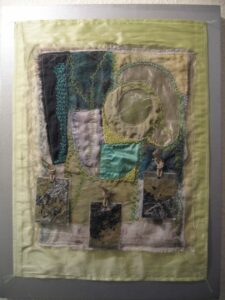
Christine: Recurrent themes usually occur when I am exploring ideas around a theme such as family, recollections and memories which is the case with ‘Threads of Life I – V’. This was followed by ‘Torn Jacket’ where I used ash from burnt letters. ‘A torn jacket is soon mended but hard words bruise the heart of a child’ – Henry Wadsworth Longfellow.
At the moment I am producing a body of work which combines painted surfaces and stitched elements, loosely based on journeys and maps. The first two pieces were abstracted oil painted surfaces – ‘Safe Harbour I and II’ which fed into subsequent work. In the latest two pieces I have attached pieces of fabric to the surface of the acrylic painted base. These are made using bright colours which represent fairground rides which figured in my childhood as I grew up on the coast.
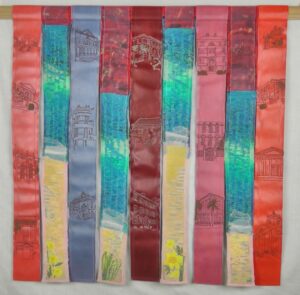
I like to have something to say in my work, as in the ‘Charleston’ piece where the centre panel is painted brown to represent the skin colour of the slaves who toiled so hard on the plantations in South Carolina. It was their blood, sweat and tears that created the beautiful mansions and plantation houses, the central motif is a slave hut.
Leslie: What feelings/moods and what experiences are you trying to explore in your art? How do you do that?
Christine: I am trying to explore my responses to certain aspects of the world around me. I made paintings of flowers as a response to the occasion and beauty of a gift, to capture that particular time.
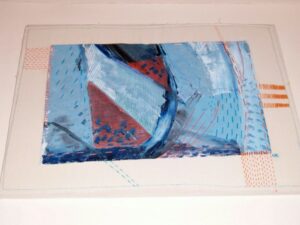
Earlier paintings were painted ‘on the spot’ such as those in the Middle East, but the later Caribbean paintings were made using experience of the place, drawings and photographs.
I think I work intuitively but sometimes it is hard create and at others it comes easier, things fall into place in a way that works.
Leslie: Whose work has influenced you – what have you taken/gained/developed from their work and ideas?
Christine: I love the drawings and paintings by Van Gogh, paintings by Bonnard, Vuillard and Paul Klee for their textural qualities and use of colour. I love the paintings by Winifred Nicholson, Anne Redpath and Mary Fedden. The textiles of Louise Bourgeois and Eva Hesse are inspirational. Contemporary textile artists such as Caroline Bartlett, Alice Kettle and Audrey Walker have inspired me.
I look at the work of artists and gain inspiration, I then develop my own ideas.
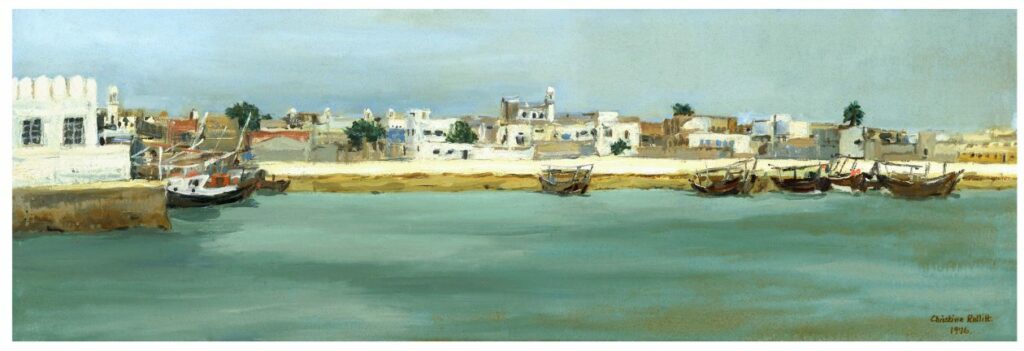
Leslie: What do you think of as your own best work so far – what makes this work important?
Christine: I am proud of my painting – ‘Muharraq Coastline’ because it now holds historical interest. I painted this in 1976 so the island of Bahrain has since changed enormously.
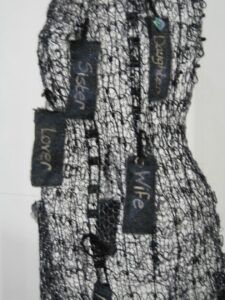
I felt proud to see my three dimensional piece ‘Give More Time’ hanging in the Menier Gallery, London. This work had taken me considerable time to resolve and caused me to forfeit my place as a member of the Prism textile group. I could not find a suitable way to display the work but then lighted upon a dressmaker’s body shape in a friend’s loft. My family found it “dark” but to me it explored the roles that a woman may or may not play during her lifetime – sister, friend, wife, mother, widow for example. It is important because I worked through a struggle and found a resolution.
Leslie: Thank you, Christine, for a very honest and illuminating interview. Next week I’m interviewing JO YOUNG, shortlisted for the Flambard Poetry Prize, about her writing and her views on war as a woman and an army reservist.
ABOUT LESLIE TATE’S BOOKS:

I interviewed writer Julia Lee Barclay-Morton about her experience of autism. Julia began as an experimental dramatist in New York, moving to the UK to

I interviewed Gillean McDougall from Glasgow, who edited the collaborative projects Honest Error (on Charles Rennie Mackintosh and his wife Margaret Macdonald) and Writing the

I interviewed French writer Delphine de Vigan, whose book, No et moi, won the prestigious Prix des libraires. Other books of hers have won a clutch

I interviewed Joanne Limburg whose poetry collection Feminismo was shortlisted for the Forward Prize for Best First Collection; another collection, Paraphernalia, was a Poetry Book Society Recommendation. Joanne

I interviewed Katherine Magnoli about The Adventures of KatGirl, her book about a wheelchair heroine, and Katherine’s journey from low self-esteem into authorial/radio success and
| Cookie | Duration | Description |
|---|---|---|
| cookielawinfo-checkbox-analytics | 11 months | This cookie is set by GDPR Cookie Consent plugin. The cookie is used to store the user consent for the cookies in the category "Analytics". |
| cookielawinfo-checkbox-functional | 11 months | The cookie is set by GDPR cookie consent to record the user consent for the cookies in the category "Functional". |
| cookielawinfo-checkbox-necessary | 11 months | This cookie is set by GDPR Cookie Consent plugin. The cookies is used to store the user consent for the cookies in the category "Necessary". |
| cookielawinfo-checkbox-others | 11 months | This cookie is set by GDPR Cookie Consent plugin. The cookie is used to store the user consent for the cookies in the category "Other. |
| cookielawinfo-checkbox-performance | 11 months | This cookie is set by GDPR Cookie Consent plugin. The cookie is used to store the user consent for the cookies in the category "Performance". |
| viewed_cookie_policy | 11 months | The cookie is set by the GDPR Cookie Consent plugin and is used to store whether or not user has consented to the use of cookies. It does not store any personal data. |